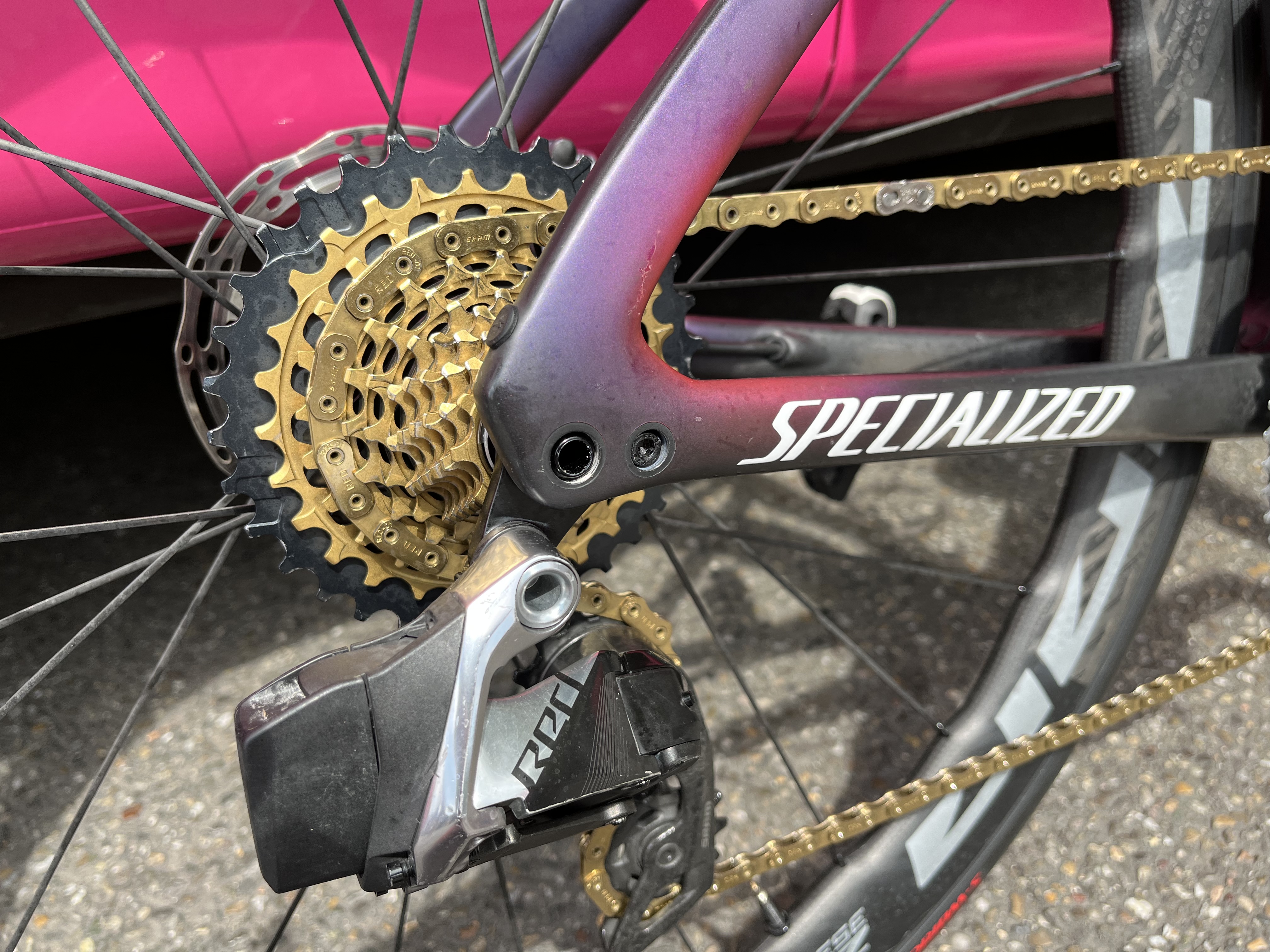Gear check: What gear ratios did riders choose to conquer the Grand Ballon?
The Tour de France Femmes peloton changed their gearing for the final weekend in the Vognes Mountains

Saturday’s seventh stage at the Tour de France Femmes avec Zwift was the first of two tough climbing stages this weekend, which are set to decide the general classification and overall winner of the race.
With that in mind, Cycling Weekly went to the start in Sélestat to visit some of the bigger teams to see how the mechanics aim help their riders deal with the punishing climbs of the Vosges Mountains.
With so much climbing ahead most teams altered their gearing, with some interesting and varied choices being made.
Movistar
The winning bike on stage seven was Annemiek van Vleuten’s Canyon AeroRoad equipped, like many other bikes among the top women’s teams, with SRAM Red AXS eTap. The Dutch star, who won the day by a huge 3:26 margin, had different gearing to the rest of the Movistar team.
While the whole team were running 52/39 chainrings at the front, most of the Spanish squad were equipped with 10/33 at the back. However, with her extra climbing prowess, and the need to be able to attack hard, Van Vleuten had a 10/30 cassette.

SD WORX
SD Worx took a different approach to most other teams, leaving their bikes as they are for most other races.
Also riding SRAM Red AXS eTap, the Dutch squad rode 49/35 at the front, with 10/33 cassettes. One thing to note is that their two former world champions, Chantal van den Broek-Blaak (road, 2018) and Lotte Kopecky (Madison,2017 and Points Race, 2021) both have rather blingy gold chains and cassettes.
The latest race content, interviews, features, reviews and expert buying guides, direct to your inbox!

Jumbo-Visma
Marianne Vos has spent five days riding in the race leader’s maillot jaune and her Jumbo-Visma team had the most changes, with all but one rider — Noemi Rüegg — starting the day on Cervélo’s climbing bike, the R5. The Swiss rider chose to ride her more aero S5, which has been used by the rest of the team for the earlier stages.
The Dutch squad did not change their gearing. The squad uses a Shimano’s Dura-Ace groupset with 53/36 chainrings and 11/32 cassettes at the back.
Trek-Segafredo
Trek-Segafredo allow their riders to choose their own gearing and tyre pressures, and both are a closely guarded secret, suggesting some odd choices or unreleased tech. However, the team would disclose a couple of changes made for the Tour’s final two stages.
Both American Leah Thomas and the home favourite and French national champion Audrey Cordon-Ragot selected a 10/33 cassette at the back of their SRAM Red AXS eTap equipped bikes. However, while Thomas chose 50/37 chainrings, Cordon-Ragot went with 52/39 chainrings.
DSM
The whole DSM squad rode their Shimano Dura-Ace equipped Scott Foils with the standard combination for the penultimate day’s racing. With the C36 wheels, the team ran 52/36 at the front and 11/34 at the back.
One interesting snippet is that, for Wednesday’s gravel stage, the team used their old 11 speed Shimano Dura-Ace C40 wheels which are 12 speed compatible.
BikeExchange-Jayco
The Australian team are another Shimano equipped squad and geared down for the mountains. While they normally run a 53/36 combination, for the weekend they switched to 53/34. This wide ration can cause some issues shifting between big and little rings, so raiders were advised by the mechanics to ease off the power while changing gear.
Otherwise it was a pretty standard 11/30 that Urška Žigart rode to eighth place, finishing 7:23 down.
FDJ-SUEZ- Futuroscope
Cecilie Uttrup Ludwig’s French squad geared down but only slightly on their Shimano equipped Lapierre bikes.
Instead of using 53/36 they dropped one tooth and ran a 52 big ring, using a 11/34 cassette instead of 11/30.

Shimano neutral service
As expected, the Shimano neutral service bikes were all equipped with the Japanese company’s Dura-Ace wheels and groupsets.
The bikes resemble a repainted Cannondale SuperSix-Evo, all with 52/36 at the front and 11/30 at the back. Unsurprisingly, there was a variety of sizes and pedals on the neutral bikes, with Look, Time, SpeedPlay and, of course Shimano Dura-Ace all present.
Many riders saw the stage to Le Markstein as the event’s Queen stage. Petit Ballon was the opening of three first category climbs, over nine kilometres at 8.1% it was a tough start and followed by Col du Platzerwasel.
That was pretty tough too, 7.1km at an average gradient of 8.3%, but the final ascent of Le Grand Ballon was harder, the 13.5km climb averaging 6.7km, though at least it was fairly constant for the later kilometres.
The final stage up to the Planche Des Belles Filles is no less tough and riders will likely opt for the same setup.
Owen Rogers is an experienced journalist, covering professional cycling and specialising in women's road racing. He has followed races such as the Women's Tour and Giro d'Italia Donne, live-tweeting from Women's WorldTour events as well as providing race reports, interviews, analysis and news stories. He has also worked for race teams, to provide post race reports and communications.